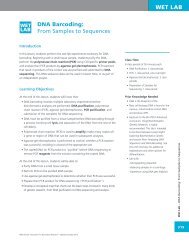LESSON 4 Using Bioinformatics to Analyze Protein Sequences
LESSON 4 Using Bioinformatics to Analyze Protein Sequences
LESSON 4 Using Bioinformatics to Analyze Protein Sequences
Create successful ePaper yourself
Turn your PDF publications into a flip-book with our unique Google optimized e-Paper software.
<strong>LESSON</strong> 429. Show students Slide #12, and ask students, “How do we know where <strong>to</strong>start translation?”<strong>Bioinformatics</strong> & <strong>Protein</strong>s: Slide #1230. Tell students that all of the answers they gave above may be correct. In thisexample, there are two unrelated start codons on both strands (circled), andbecause this is only a small piece of DNA, there may be start codons in otherregions of the sequence that we cannot see. Genes are often hundreds orthousands of bases long.31. Explain <strong>to</strong> students that knowing where <strong>to</strong> start translation involves knowingwhich reading frame <strong>to</strong> use. Each reading frame is a possible way <strong>to</strong> read aseries of base triplets <strong>to</strong> specify the amino acids.32. Show Slide #13, “What are Reading Frames?” Ask students how we knowhow <strong>to</strong> read the “gene” sequence “thecatatetherat?”• If we were like cells making proteins, we could “read” the protein in thefirst reading frame (+1), starting at the first letter, “the cat ate the rat.”• If we didn’t know that this was English, we could start at the second letter,in reading frame +2, “t hec ata tet her at” or the third reading frame (+3),“th eca tat eth era t.”• If there were a “complement” <strong>to</strong> this sentence, as there is with DNA,reading frames -1, -2 and -3 would be like reading the sentence backwards.• The period at the end of the sentence is like a s<strong>to</strong>p codon, telling us <strong>to</strong> s<strong>to</strong>preading (or s<strong>to</strong>p making protein).• The open reading frame is the portion of the gene that could potentiallyencode a protein because it contains a start and a s<strong>to</strong>p codon, andcodons <strong>to</strong> make amino acids in between. The “open” reading frame is the“correct” reading frame. The reading frame is said <strong>to</strong> be “open” because itis not interrupted by s<strong>to</strong>p codons.Reading frame: A reading frame isa contiguous and non-overlappingsequence of three-nucleotide codons inDNA or RNA. There are three possiblereading frames in an mRNA strand andsix in a double-stranded DNA molecule(three reading frames from each of thetwo DNA strands).Open reading frame: A reading framethat contains a start codon and a s<strong>to</strong>pcodon, with multiple three-nucleotidecodons in between. The open readingframe in a particular region of DNA isthe correct reading frame from which<strong>to</strong> translate the DNA in<strong>to</strong> protein. Thelongest open reading frame is the onethat’s most likely <strong>to</strong> be correct.Lesson 4 – <strong>Using</strong> <strong>Bioinformatics</strong> <strong>to</strong> <strong>Analyze</strong> <strong>Protein</strong> <strong>Sequences</strong>131©Northwest Association for Biomedical Research—Updated Oc<strong>to</strong>ber 2012
















